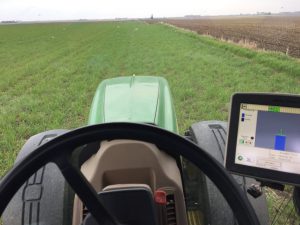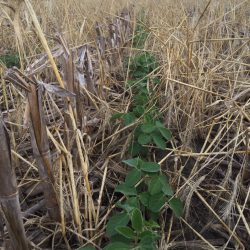Humboldt County farmer Doug Adams had a plan A for the spring planting season, but wet conditions forced him to make some adjustments. Despite less-than-ideal weather so far this growing season, he’s optimistic corn and soybeans have near-trend yield potential.

Corn planting began April 22 and wrapped up May 16. He made it a priority to get the corn planted on a new piece of land, which is a wet farm and was tilled in the fall by the previous owner. He planted it first because it was mostly dry early in the spring, and being across the road from his house gave him the ability to fill in wet spots later. But that’s the only piece of ground that was planted in April. “We had rain and even some snowfall in late April,” he said.
On May 4, his rye cover crop was terminated and corn planting resumed. “I like to plant the corn using a strip-till system, but since it was getting later than I liked, I no-tilled all the corn this year,” he said. “The rye cover crop did its job this spring. It supported the equipment and drew the moisture from the surface to keep us in the fields.”
Adams was pleased with the growth of the cover crops this spring and late-spring nitrogen tests signal it did its job recycling nutrients. “Either we didn’t have enough rainfall to drive the nitrogen out of the soil profile or my soil is starting to cycle the nutrients,” he said. “I think it’s possible I’ve been using no-till and strip-till along with cover crops long enough to see the payback.”
Once corn planting was complete, the rain began to fall. Adams waited until June 4 to plant soybeans. That planting window remained open until June 8, which was just enough time to plant all his intended acres.

The rye on the soybean ground had more time to establish. “I sprayed the cover crop ahead of soybean planting instead of crimping like I usually do because the ground was wet. I didn’t want to create a lot of mulch on the soil surface because soybeans don’t like wet feet,” he said.
While he made some adjustments to his original plan, he has become accustomed to wet spring weather throwing curve balls. “I encourage farmers that haven’t done any no-till to give it a try – even if it’s just a few acres,” said Adams. “It made a world of difference for me this year. I was in the fields a few days sooner than others without causing any damage to the soil.
“Because of the wet fall, a lot of farmers didn’t get their tillage complete and some farmers in this area gave no-till a try. I think their crops look really good, and if those farmers are happy with how it looks this year, they will have success with no-till during a more normal growing season,” added Adams.
Click here to ask Doug a question about his farming operation.
